Whether you spent the winter hitting the gym, on the slopes, or binging Netflix, your body could probably use a spring tune-up in preparation for warmer weather and lots of summer hiking. Hiking seems much more enjoyable when you can focus on the stellar view and keep up a conversation with your buddies, rather than thinking about your next break while you huff and puff uphill. Plus, you’ll decrease your chances of getting injured if you’re less fatigued and more physically prepared.
Stretch First!
Before you start anything, make sure you limber up. Stretching is crucial to prevent muscle imbalances and to recover from hard workouts or hikes. Remember, dynamic stretches are meant for warm-ups (arm circles, leg swings), and static stretches (ones without movement) are for cooling down. Hiking relies greatly on your calves, hamstrings, quads, and IT band, so make sure you’re keeping these muscles happy.
Here is an extremely effective quad stretch: Get on one knee (proposal style) near a wall, with your back facing it. Scoot back, until the knee on the ground is a few inches from the wall, and fold the bottom of your leg up behind it. You’ll likely have to lean forward to get into this position. Then, slowly start to lean back while straightening up. Be careful not to go too far too fast. Eventually, your back should be parallel to the wall, although this may take some practice. Hold this stretch for a few minutes, and focus on steady breathing. It’s helpful to do this on carpeting or to place a mat under your knee, but you can even do it outside against a tree.
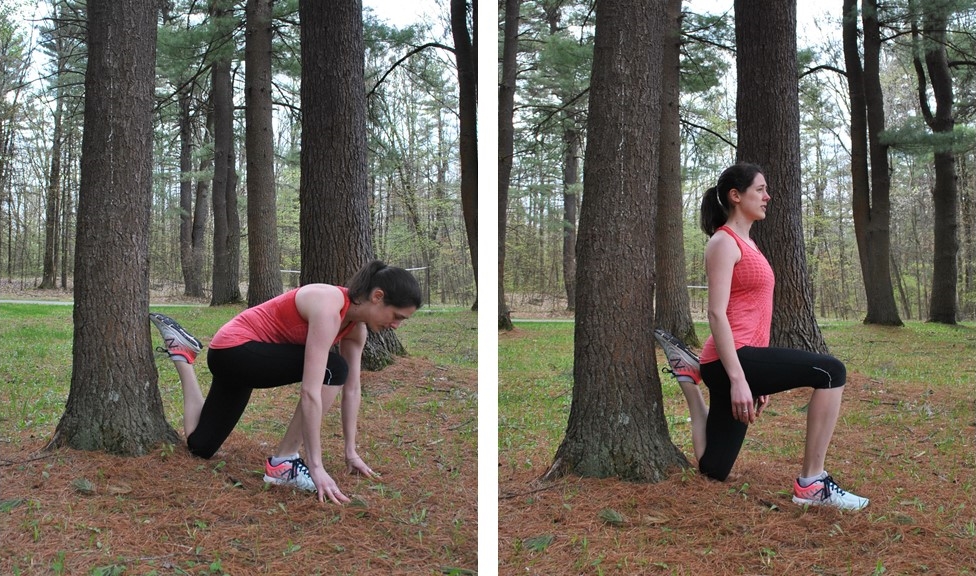
Most of the moves listed below include weights, but if you don’t have access to any, you can wear your hiking pack stuffed with books or water bottles. You may also opt for beginning without weights, as your own body weight will provide good resistance. The moves may seem difficult at first, but the goal is to work multiple muscles at once while raising your heart rate—similar to what your body experiences during a hike. You can work these into your normal routine by doing three sets of 10 to 15 reps or by alternating intense periods of “work” with shorter periods of rest.
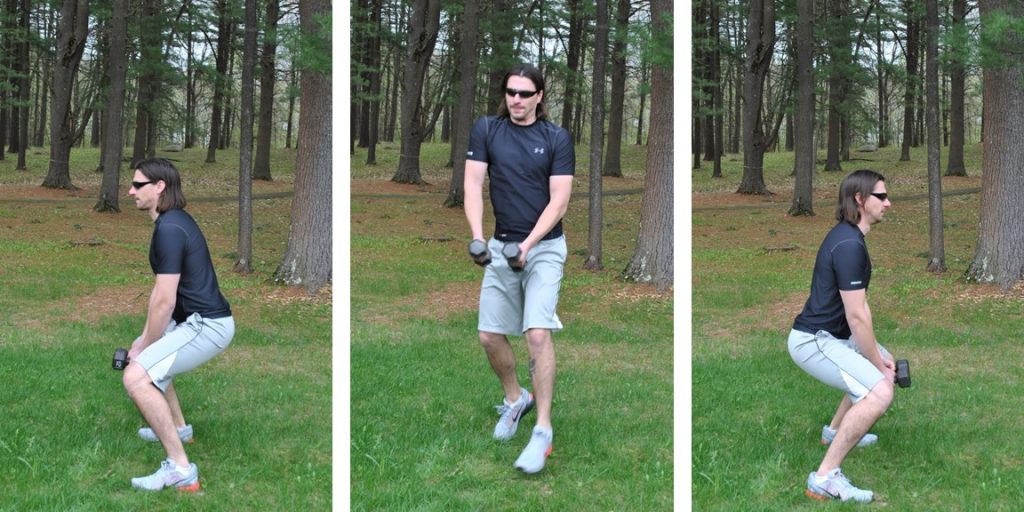
1. Snowboard Jump Squats
Muscles Used: Quads, glutes, hip flexors, core, calves, hamstrings, lower back
How it Helps: This will build the speed, strength, and aerobic capacity needed to scale mountains by fully engaging the lower body and core. The explosiveness of the movement will help you powerfully climb those steep sections.
To Do: Stand with your feet wider than your shoulders and your toes pointed slightly outward, and hold a set of dumbbells between your legs. Squat low and pulse three times before simultaneously jumping and spinning clockwise in the air. The goal is to land 180 degrees from where you began, maintaining the same wide stance. Squat low, pulse three times, and again jump and spin, but this time, do it in a counterclockwise motion. If your balance isn’t great, you might want to practice these a few times without weights.
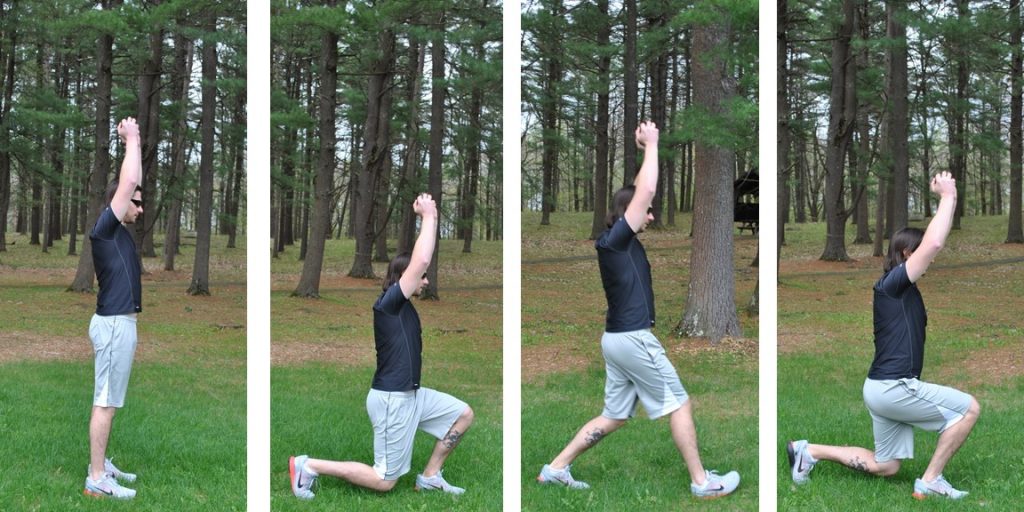
2. Walking Lunge with Overhead Weight
Muscles Used: Quads, glutes, hamstrings, hip flexors, core, deltoids
How it Helps: Increases leg power and speed and improves core stability while you move. This results in a stronger, faster, and better-balanced hiker.
To Do: Start with your feet together and a dumbbell or plate in your hands. Raise the weight overhead, and with your right leg, take a large step forward into a lunge position. Push off your back (left) leg, and then, bring it forward past your right leg into another lunge position. Keep the weight raised overhead the entire time. Keep alternating legs, in a walking manner. Try to move between legs fluidly, not letting your foot hit the ground while you transition into the next lunge. This may be difficult at first, but will help improve balance.
Alternatives: Hold the weight out in front of your chest, or hang it at your side.
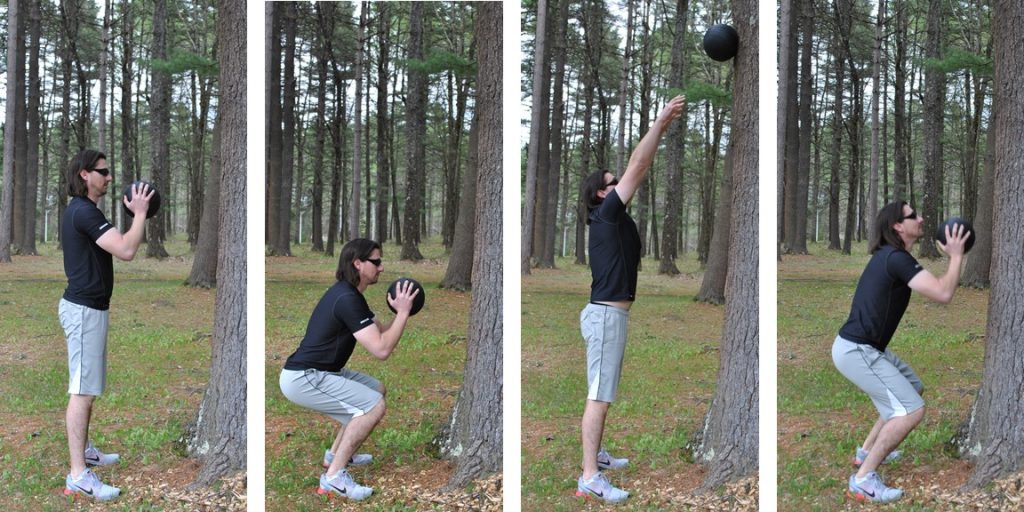
3. Wall Balls
Muscles Used: Quads, glutes, calves, hamstrings, abs, chest, lower back, deltoids, biceps, triceps
How it Helps: This total body conditioning and functional movement engages numerous muscles while increasing cardiac capacity. This makes a strong hiker who isn’t sucking wind at the first incline.
To Do: Stand facing a wall, a few inches in front of it, while holding a weighted medicine ball at chest level. Sit back and bend into a deep squat position, keeping the ball at chest level. Rise up quickly, and throw the ball above your head, so it taps the wall. Catch the ball at chest level and repeat. Try getting in a few sets of these first thing every morning. No medicine ball? Fill a basketball or soccer ball with clean sand and patch it up.

4. Bulgarian Split Squat with Press
Muscles Used: Quads, glutes, hamstrings, deltoids, shoulders
How it Helps: Increases leg and arm strength while improving balance, which aids you in traversing steep and uneven terrain.
To Do: Stand a few feet in front of a bench or step, with the toes of the left foot on the bench and a dumbbell in your right hand at shoulder height. Lower into a deep lunge, briefly pausing at the bottom of the movement. Rise back up, pressing the weight above your head as you do. Repeat, lowering the weight to your shoulder as you lower into the lunge again. Do a set of 10 to 15 before switching legs.
Alternative: Hold a set of dumbbells at your sides.
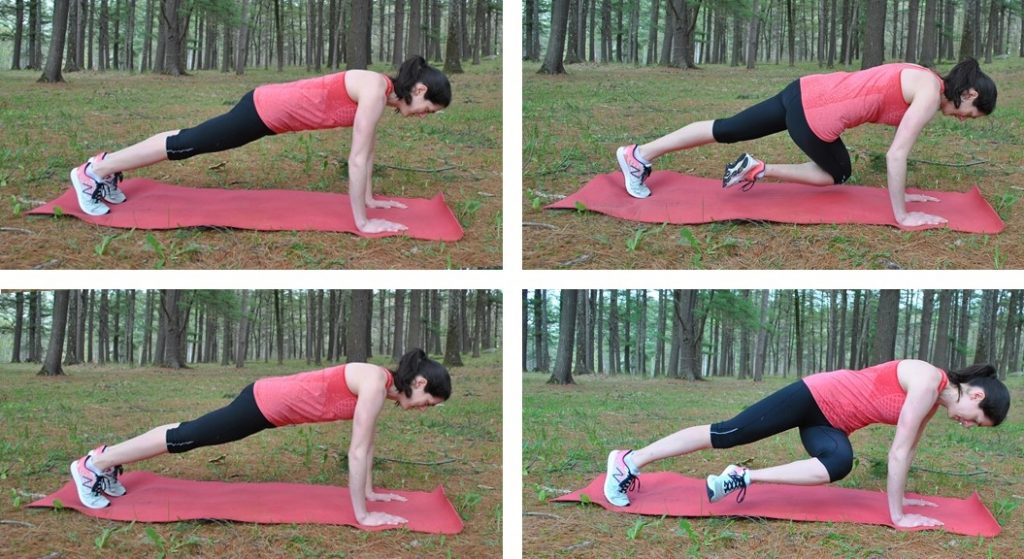
5. Plank Knee Twist
Muscles Used: Abs, obliques, glutes, hamstrings, deltoids, calves
How it Helps: Strengthens your core, which helps to keep you stable while hiking and to prevent back injuries.
To Do: Get in a high plank position (arms fully extended and palms on the floor). Bring your right knee to your left elbow. Return to plank position. Bring your left knee to your right elbow. When returning to plank position, be sure not to drag your foot or lazily put it back into place. You should be fully extending your foot backward, in a smooth and controlled motion.
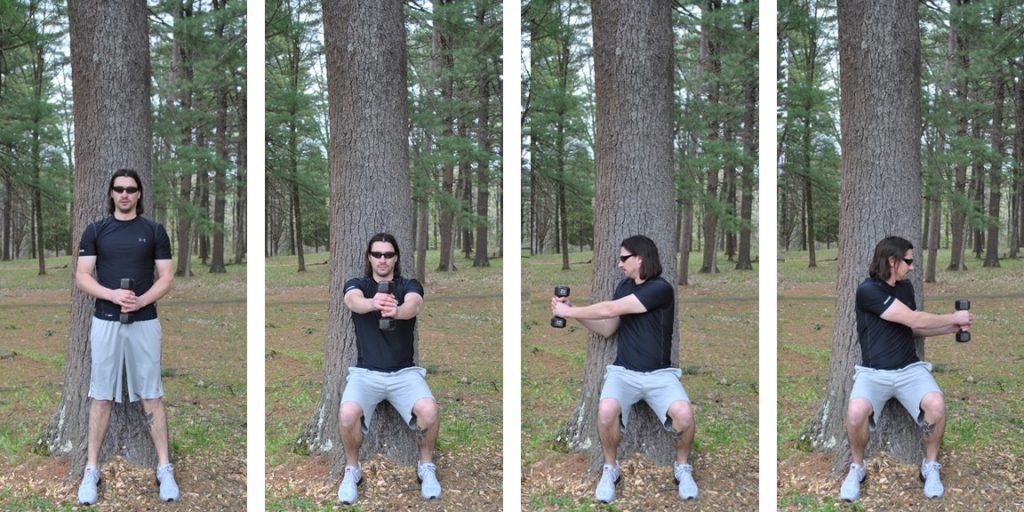
6. Wall Sits with a Twist
Muscles Used: Quads, glutes, hamstrings, abs, obliques, lower back
How it Helps: Improves balance and posture by strengthening your core. Hiking with good posture and a solid core is key to preventing injuries, slips, and falls.
To Do: Stand with your back against a wall, with your feet slightly wider than your shoulders, as you hold a dumbbell or plate with both hands. Slowly slide down the wall while walking your feet out until the top of your legs are parallel with the ground. Your feet should be far enough out that your knees do not extend over your toes. Keeping your shoulders against the wall, move the weight from the right side of your body to the left, gently touching the wall at each side. To get some fresh air and increase the burn, do these outside against a tree, and try to reach as far as you can around the side of the tree.
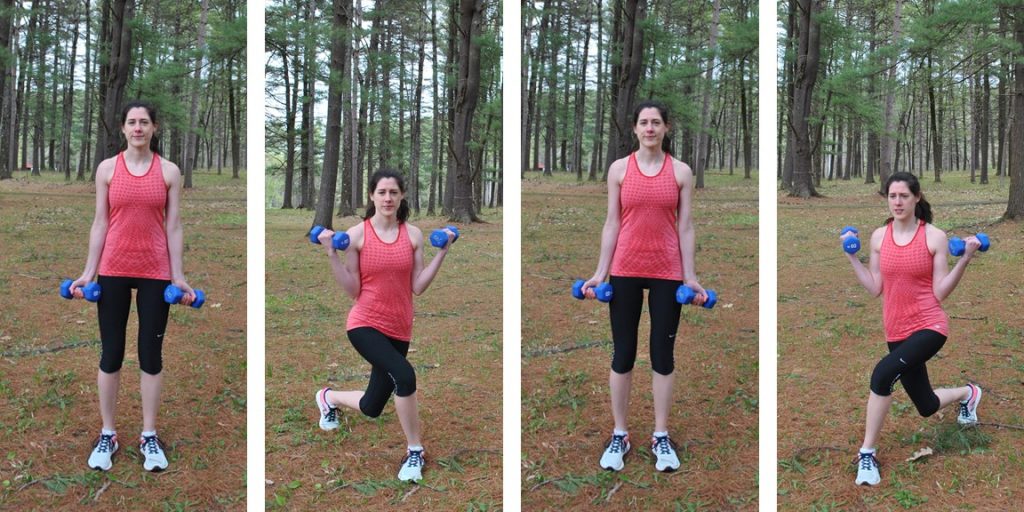
7. Curtsy Lunge
Muscles Used: Glutes, hamstrings, quads, inner thighs, biceps, lower back
How it Helps: Strengthens the lower body while increasing your range of motion and improving balance. This allows hikers to tackle tough terrain with confidence.
To Do: Begin standing with your feet together, holding a set of dumbbells at your sides with your palms facing forward. Sweep the right leg behind and past the left leg, lowering into a curtsy. As you descend, curl the weights up, so your forearms are parallel with the ground (bicep curl). Push off the right leg, lower the weights, and return to your starting position, pausing only briefly before switching to the left leg.
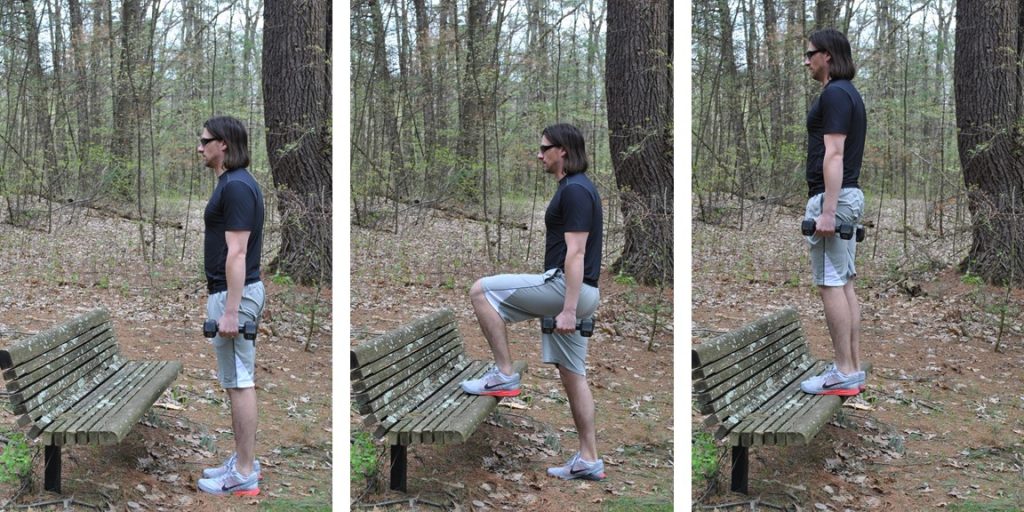
8. Climbing Stairs or Step-Ups
Muscles Used: Quads, glutes, hamstrings, calves, lower back, core
How it Helps: Climbing stairs greatly mimics climbing a mountain, making it an ideal way to train for hiking. Step-ups are a multi-joint movement that will strengthen your legs and stabilize muscles that keep you strong and limber on your feet.
To Do: Get after ‘em wherever you can: in your office building, a nearby stadium, or the stair climber at the gym. Have a shortage of stairs? Do step-ups instead. All you need is a bench or a sturdy surface higher than where you are standing (12 inches or higher is preferable). Hold dumbbells at your sides, and alternate the foot with which you step up, or do sets of 10 to 15 on each leg to really feel the burn.
9. Running
How it Helps: Hiking can really put your cardiovascular system to the test and is a great way to build endurance, allowing you to take fewer breaks and comfortably keep up conversation.
To Do: Hit the trails to get comfortable moving on uneven terrain and navigating obstacles like rocks and roots. Trail running also helps to strengthen your ankles and the muscles, ligaments, and tendons that stabilize them while you hike. This helps to prevent common injuries like a sprained ankle. You can also train with interval runs, or fartlek (“speed play” in Swedish), by alternating periods of sprinting with periods of walking or light jogging. And, don’t forget to work hills into your run. Not only will hills amp up the cardio quickly, but they also strengthen leg muscles. Try to run at least three days per week: a longer trail run done at a comfortable space, a 20- to 30-minute interval run, and an exceptionally hilly run.
Sarah Quandt
Sarah learned an appreciation for all the Northeast has to offer from a young age, with her parents stuffing her in the family van for countless road trips. Despite being a little girl living in Upstate NY, she was somehow convinced she was destined to be a professional surfer. Thankfully she discovered the more geographically appropriate hobby of snowboarding while attending the X-Games in Vermont. She spends most of her time trail running, hiking and snowboarding but is always looking for a new challenge. As a current Adirondack 46er, Sarah is now working on solo-hiking all of the ADK high peaks. She balances her love for travel and adventure with her career as a civil/environmental engineer and resides in Saratoga Springs, NY with her husband and adorable dog.
Related Posts
April 2, 2024
10 Tips for Mountain Biking Etiquette During Mud Season
One rough spring could ruin the…




